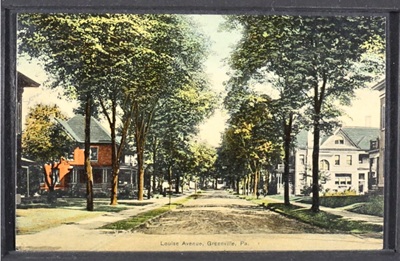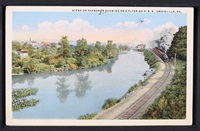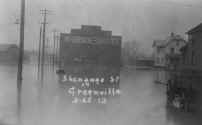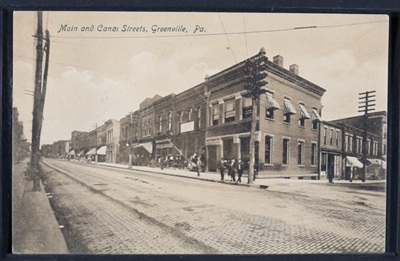The early settlement was destitute of any means of public conveyance to, or from the place until the turnpike was built from Pittsburgh to Erie, which was completed in the summer of 1816. David Leech had the contract for building that portion extending through Mercer county. "Going to Georgetown or Mercer to take the stage," was as common a phrase as it is today "to take the cars" at one of our railroad stations. The place now began to be favored with a weekly mail, carried on foot from Mercer. A post office was now granted and Mr. Alexander P. Waugh appointed Postmaster under the administration of John Quincy Adams. The revenue of the office at this time reached $5 per quarter.
The first newspaper seen in the place was the Pittsburgh Gazette; but a county paper was established at an early day in the history of the county and was taken by all the reading people of the county without regard to politics. The Western Press was established by Jacob Harrington in 1806; The Mercer Luminary in 1814 by J. Morehead; the Greenville Gazette, now the Shenango Valley Argus, in 1830, by Richard Hill; the Greenville Advance established in 1870 by W. H. H. Dumars. And, as this county exceeds any county in the State in the number of weekly papers, they might be enumerated in their order: The Mercer county Whig, (now Dispatch) in 1844, by J. B. Butter; the Sharon Herald, by W. H. Frey in 1860; the Sharon Times, by Geo. D. Herbert in 1865; the Sharpsville Advertiser, by Jonas Pierce in 1870; the Jamestown Sun, by D. L. Calkins in 1873; the Sandy lake News,by J. F. Johnston in 1874; making nine respectable weekly papers in the county.
In the year 1836, the Erie Extension Canal was located and put under contract from New Castle to Erie. This enterprise noted an epoch in the history of Greenville that has not been equaled by any improvement since that time. Real estate doubled, tripled and quadrupled itself in a few weeks. In the spring of 1840, the first canal boat arrived here from Pittsburgh ladened with merchandise. The change was at once brought about - that of carrying freight by water instead of hauling by wagon, with no little grumbling on the part of teamsters, their calling gone, and not seeing the advantage of the public improvement. In 1842 the first trip was made through the entire length of the canal to Erie. Forty years have now passed away since this great work was begun, and today, it has passed away, and must be numbered amongst the things that were. The more modern improvement of locomotive power have taken its place.
Another epoch in the history of Greenville, took place in 1844, by the iron business that was begun in that year. Two blast furnaces were built on the west side of the Shenango; the first one by a company of citizens of the place, headed by John A. Waugh; the second one by Himrod & Vincent, of Erie. The manufacture of pig iron by raw cool being a success, gave an impetus to the business that lasted until the coal became, in a measure, exhausted in the coal mines of the upper end of the valley.
Greenville of today, presents a town of 3,500 inhabitants, with some 30 business blocks built of brick, with foundrys, machine shop, carriage and wagon manufacturies, planing mills, lumber mills and rolling mills - with graded streets, shaded avenues, handsome private residences, unequaled by any town of its numbers in the State. In well finished churches and elegant public buildings, of which Thiel College stands permanently situated on an eminence in a beautiful oak grove, overlooking the town and country for miles in every direction.
(Source: The Record-Argus, Sat., Nov. 14, 1874, pg. 5)
 Louise Avenue |  Main Street |  The Erie Flyer |
 Flooding on Shenango Street in 1913 |  Main & Canal Streets (click on image to enlarge) |
Historical Population
Source: Wikipedia, The Free Encyclopedia |
<<<Return to Greenville Home Page